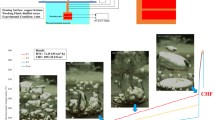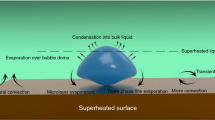Abstract
Pool boiling heat transfer measurements from heaters of varying aspect ratio were obtained in low-g (0.01 g ± 0.025 g) and high-g (1.7 g ± 0.5 g) using the KC-135 aircraft. The heater aspect ratio was varied by selectively powering 2×2, 2×4, 2×6, 2×8, and 2×10 arrays of heaters in a 10×10 heater array containing individual heaters 700×700 μm2 in size. Control circuitry was used to maintain a nominally isothermal boundary condition on the heater surface while the power dissipated by the heater was measured. Steady-state boiling data in low-g and high-g were obtained using FC-72 as the working fluid at two bulk fluid temperatures. At high wall superheats, boiling performance appears to decrease with an increase in aspect ratio. Strong thermocapillary convection was observed for a negligible gas concentration in the liquid. CHF was not observed for the heater used in this study indicating that CHF in low-g may be highly dependent on the surface characteristics of the heater in addition to the heater size.
Similar content being viewed by others
References
Viskanta, R. et al: Microgravity Research in Support of Technologies for the Human Exploration and Development of Space and Planetary Bodies. Topical Report of the National Research Council-Space Studies Board (2000).
DiMarco, P.: Review of Reduced Gravity Boiling Heat Transfer: European Research. Japan Society of Microgravity Application Journal, vol. 20, no. 4, p. 252–263 (2003).
Kim, J.: Review of Reduced Gravity Boiling Heat Transfer: US Research. Japan Society of Microgravity Application Journal, vol. 20, no. 4, p. 264–271 (2003).
Ohta, H.: Review of Reduced Gravity Boiling Heat Transfer: Japanese Research. Japan Society of Microgravity Application Journal, vol. 20, no. 4, p. 272–285 (2003).
H. Merte, H. S. Lee and R. B. Keller: Dryout and Rewetting in the Pool Boiling Experiment Flown on STS-72 (PBE-IIB) and STS-77 (PBE-IIA). NASA/CR-1998-207410 (1998).
Kim, J., Benton, J.F., andWisniewski, D.: Pool Boiling Heat Transfer on Small Heaters: Effect of Gravity and Subcooling. International Journal of Heat and Mass Transfer, vol. 45, p. 3919–3932 (2002).
Straub, J.: Origin and Effect of Thermocapillary Convection in Subcooled Boiling: Observations and Conclusions from Experiments Performed at Microgravity. Ann. New York Acad. Sci. 974, p. 348–363 (2002).
Henry, C.D. andKim, J.: Heater Size, Subcooling, and Gravity Effects on Pool Boiling Heat Transfer. International Journal of Heat and Fluid Flow, vol. 25, no. 2, p. 262–273 (2004).
Rule, T.D. andKim, J.: Heat Transfer Behavior on Small Horizontal Heaters During Pool Boiling of FC-72. Journal of Heat Transfer, vol. 121, no. 2, p. 386–393 (1999).
Bae, S., Kim, M., Kim, J.: Improved Technique To Measure Time-And Space-Resolved Heat Transfer Under Single Bubbles During Saturated Pool Boiling Of FC-72. Experimental Heat Transfer, vol. 12, no. 3, p. 265–278 (1999).
Author information
Authors and Affiliations
Rights and permissions
About this article
Cite this article
Henry, C.D., Kim, J. Thermocapillary effects on low-g Pool Boiling from microheater arrays of various aspect ratio. Microgravity sci. Technol. 16, 170–175 (2005). https://doi.org/10.1007/BF02945970
Issue Date:
DOI: https://doi.org/10.1007/BF02945970




